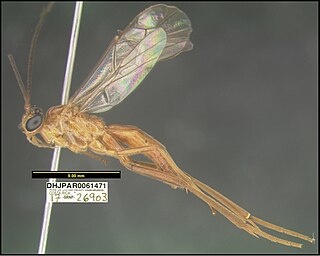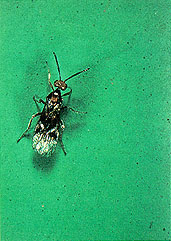
Sawflies are wasp-like insects that are in the suborder Symphyta within the order Hymenoptera, alongside ants, bees, and wasps. The common name comes from the saw-like appearance of the ovipositor, which the females use to cut into the plants where they lay their eggs. The name is associated especially with the Tenthredinoidea, by far the largest superfamily in the suborder, with about 7,000 known species; in the entire suborder, there are 8,000 described species in more than 800 genera. Symphyta is paraphyletic, consisting of several basal groups within the order Hymenoptera, each one rooted inside the previous group, ending with the Apocrita which are not sawflies.

The superfamily Ichneumonoidea contains one extinct and three extant families, including the two largest families within Hymenoptera: Ichneumonidae and Braconidae. The group is thought to contain as many as 100,000 species, many of which have not yet been described. Like other parasitoid wasps, they were long placed in the "Parasitica", variously considered as an infraorder or an unranked clade, now known to be paraphyletic.

The Ichneumonidae, also known as ichneumon wasps, ichneumonid wasps, ichneumonids, or Darwin wasps, are a family of parasitoid wasps of the insect order Hymenoptera. They are one of the most diverse groups within the Hymenoptera with roughly 25,000 species described as of 2016. However, this likely represents less than a quarter of their true richness as reliable estimates are lacking, along with much of the most basic knowledge about their ecology, distribution, and evolution. It is estimated that there are more species in this family than there are species of birds and mammals combined. Ichneumonid wasps, with very few exceptions, attack the immature stages of holometabolous insects and spiders, eventually killing their hosts. They play an important role as regulators of insect populations, both in natural and semi-natural systems, making them promising agents for biological control.

The Braconidae are a family of parasitoid wasps. After the closely related Ichneumonidae, braconids make up the second-largest family in the order Hymenoptera, with about 17,000 recognized species and many thousands more undescribed. One analysis estimated a total between 30,000 and 50,000, and another provided a narrower estimate between 42,000 and 43,000 species.

Parasitoid wasps are a large group of hymenopteran superfamilies, with all but the wood wasps (Orussoidea) being in the wasp-waisted Apocrita. As parasitoids, they lay their eggs on or in the bodies of other arthropods, sooner or later causing the death of these hosts. Different species specialise in hosts from different insect orders, most often Lepidoptera, though some select beetles, flies, or bugs; the spider wasps (Pompilidae) exclusively attack spiders.

The Orussidae or the parasitic wood wasps represent a small family of sawflies ("Symphyta"). Currently, about 93 extant and four fossil species are known. They take a key position in phylogenetic analyses of Hymenoptera, because they form the sister taxon of the megadiverse apocritan wasps, and the common ancestor of Orussidae + Apocrita evolved parasitism for the first time in course of the evolution of the Hymenoptera. They are also the only sawflies with carnivorous larvae.

Microgastrinae is a subfamily of braconid wasps, encompassing almost 3,000 described species, with an estimated 30,000–50,000 total species. This makes it one of the richest subfamilies with the most species of parasitoid wasps.

Cotesia glomerata, the white butterfly parasite, is a small parasitoid wasp belonging to family Braconidae. It was described by Carl Linnaeus in his 1758 publication 10th edition of Systema Naturae.

Cystomastacoides kiddo is a species of parasitoid wasp belonging to the family Braconidae. The species was found during a 2006–2008 insect collection programme in Thailand. The name is derived from the character Beatrix Kiddo from the 2003 film Kill Bill, because of their resemblance in action and colour. It is one of the four species under the genus Cystomastacoides, and the only species in Thailand. As all other braconids, the female lays its eggs inside the body of other insects, such as moth caterpillar, so that the larvae use the host body as a source of food.

Cystomastacoides is a genus of parasitoid wasps belonging to the family Braconidae. It was named by Dutch entomologist Kees van Achterberg in 1997 from a single species Cystomastacoides coxalis discovered in Yunnan, China. There are only four species described in the genus, the other three having been reported on 19 March 2013. As typical ichneumon wasps, they are characterised by a deadly parasitoid behaviour. Their larvae grow inside the body of other insects, such as caterpillars, and feed on their internal organs inside the body until they emerge.

Spathius is a genus of doryctine wasps. The larvae of this genus of wasps feed on beetle larvae. They act as biological controllers of the certain pest beetles, such as Hylurgopinus rufipes and the emerald ash borer.

The Braconinae are a large subfamily of braconid parasitoid wasps with more than 2,000 described species. Many species, including Bracon brevicornis, have been used in biocontrol programs.

The Homolobinae are a subfamily of braconid parasitoid wasps.

Meteorinae is a subfamily of braconid parasitoid wasps; however, since 2015, most scientists have treated this clade as the Tribe Meteorini in Euphorinae. Several species have been used in biological control programs. The name for this group comes from the pupal stage, which, in species attacking Lepidopteran hosts, hangs suspended from a long thread of silk.

Trogus is a genus of parasitoid wasp found in the Holarctic and Neotropic regions. It is placed in the subfamily Ichneumoninae and the tribe Ichneumonini. Trogus species are parasites of larvae and pupae of the swallowtail butterfly family, Papilionidae. The genus consists of twelve extant and one extinct species.

Brachistinae is a subfamily of braconid wasps in the family Braconidae.
Paroplitis is a genus of braconid wasps in the family Braconidae. There are about five described species in Paroplitis.

Philoplitis is a genus of braconid wasps in the family Braconidae. There are about nine described species in Philoplitis, found in Africa and Indomalaya.

Netelia producta is a species of ichneumonid wasp in the subfamily Tryphoninae found in Australia.
Hormius is a genus of parasitoid wasp in the subfamily Hormiinae first described by Christian Gottfried Daniel Nees von Esenbeck in 1818.
Naveed k. 2019. Reseach Entomology



















